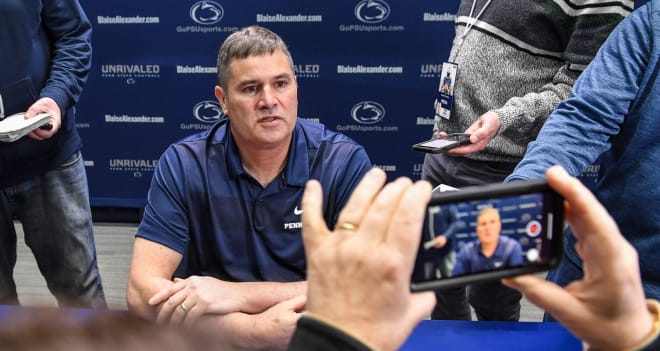By the numbers: Changing offensive tendencies under Kirk Ciarrocca
Hired as Penn State's offense coordinator to replace Ricky Rahne last December, Kirk Ciarrocca's first 11 months at Penn State have been anything but ordinary.
A pandemic ensured he couldn't install his offense the conventional way, and a stunning 0-5 start to the season has put him — and every other member of Penn State's coaching staff — under the microscope.
With a sample of five games to work from, BWI compiled data to see how the Nittany Lions' offense has differed from last season's.
The analysis that follows is intended to illustrate the differences in Penn State's tendencies — not indicate whether or not those tendencies have been effective.
Understanding that there are relatively significant variables between last season and this season outside of Ciarrocca's arrival (game script, a sharp increase in turnovers, injuries, absence of nonconference play, etc.), let's look at what we can glean from his first five games in charge.
HOLIDAY SPECIAL: Get FREE gear with new annual subscription!

The first thing to note — and perhaps, the most basic — is that Penn State is running far and away more plays than it did last season.
Last year, the Nittany Lions averaged 66.8 offensive plays per game, excluding penalties. This season, Penn State has averaged 80.2 offensive plays per game, despite producing similar amounts of total yardage per game.
You might assume that means Penn State has been generally less explosive in 2020, which is true.
The Nittany Lions averaged 6.1 yards per play last season, and have averaged 5.2 yards per play this year.
And that average has dipped despite an increased emphasis on throwing the ball this season.
Last year, the Nittany Lions ran the ball about 58 percent of the time, whereas Penn State is at just about a 50-50 split between run and pass in 2020 — possibly because Penn State has been in trailing games far more often than it did last year.
Let's get into some of the intricacies of the passing game under Kirk Ciarrocca with a look at the table below.
| Depth of attempted passes | 2019 season | 2020 season |
|---|---|---|
|
20+ yards |
17 percent |
11 percent |
|
10-20 yards |
22 percent |
34 percent |
|
0-10 yards |
44 percent |
45 percent |
|
Behind Line of Scrimmage |
17 percent |
9 percent |
The first thing you'll notice is that under Ciarrocca, there has been much more of an emphasis on the mid-range passing game.
Passes between 0-20 yards downfield have made up 79 percent of the overall passing game for the Nittany Lions in 2020, whereas they comprised just 66 percent of the passing game last year.
What's interesting about this is that Penn State hasn't only gotten away from the deep ball, it has also seemingly de-emphasized the shorter screen and checkdown passes behind the line of scrimmage that the Lions went to 17 percent of the time last season.
As for those deep balls, in 2020, Will Levis and Sean Clifford combined have completed six in five games compared to 18 in 13 games last season.
This leaves us to wonder if the change in how far downfield Penn State is throwing the ball can be explained by the personnel it has available on the field.
KJ Hamler, a frequent target downfield and around the line of scrimmage due to his speed, left for the NFL. Journey Brown, Penn State's leading pass catcher among running backs last season, isn't available. And tight end Pat Freiermuth — now out for the season — had been playing hurt for three games before opting for surgery.
Despite that, you won't find too much change in who Penn State is targeting with its passes between last year and this year.
| Position group | 2019 | 2020 |
|---|---|---|
|
WR |
62 percent |
62 percent |
|
TE |
23 percent |
25 percent |
|
RB |
15 percent |
13 percent |
|
OL |
< 1 percent |
0 percent |
As you can see, Penn State's wideouts are earning an equal share of targets relative to last season, with Jahan Dotson stepping into Hamler's role as the Nittany Lions' primary playmaker.
The only difference — outside of what must have been a thrilling single target for offensive lineman Des Holmes last season — has been a slight uptick in targets for Penn State's tight ends at the expense of its running backs.
Which brings us to our last chart, which focuses on Penn State's running game.
| Position group | 2019 | 2020 |
|---|---|---|
|
QBs |
34 percent |
49 percent |
|
RBs |
63 percent |
51 percent |
|
WRs |
1 percent |
0 percent |
The changes we see here are pretty jarring.
James Franklin has said publicly several times that he wants to limit Clifford's carries, mostly because he dealt with some injury issues last season.
That hasn't happened.
Penn State's quarterbacks are carrying the ball almost as often as its running backs this season, and, whether by cause or coincidence, the Nittany Lions are averaging about 1.5 fewer yards per carry than they did last season.
Another notable trend has been an overall decrease in touches for Penn State's running backs, which could be due to the absence of Brown and Noah Cain, who came into the season in the top two spots on the Lions' depth chart at that position.
As we noted earlier, the Nittany Lions' running backs are being targeted marginally less in the passing game compared to last season, and we can see in the table above that they haven't been nearly as busy in the running game either.
To put that in numerical perspective, despite the Nittany Lions running more plays this year, Penn State's running backs are averaging 23.8 touches per game this season, compared to last season when when they averaged 27.5.
*******
HOLIDAY SPECIAL: Get FREE gear with new annual subscription!
• Talk about this article inside The Lions Den
• Watch our videos and subscribe to our YouTube channel
• Learn more about our print and digital publication, Blue-White Illustrated
• Follow us on Twitter: @BWIonRivals, @NateBauerBWI, @RivalsSnyder, @DavidEckert98
• Like us on Facebook
